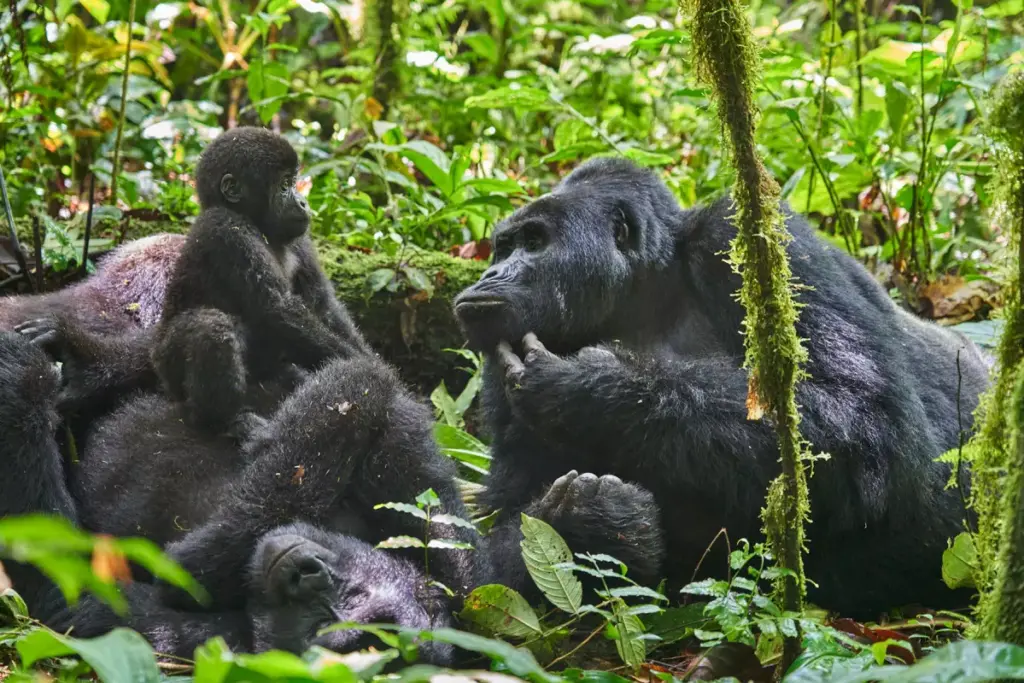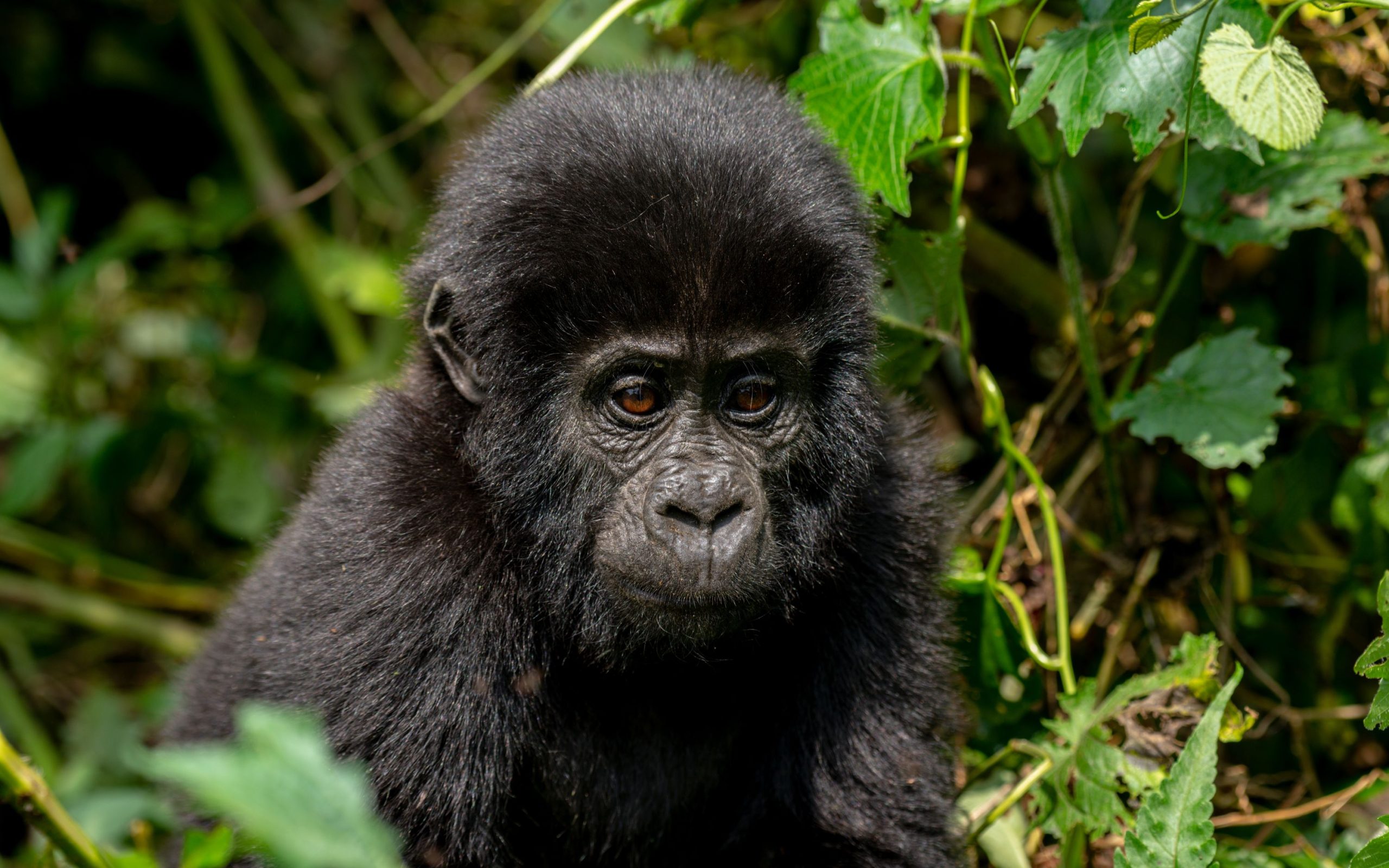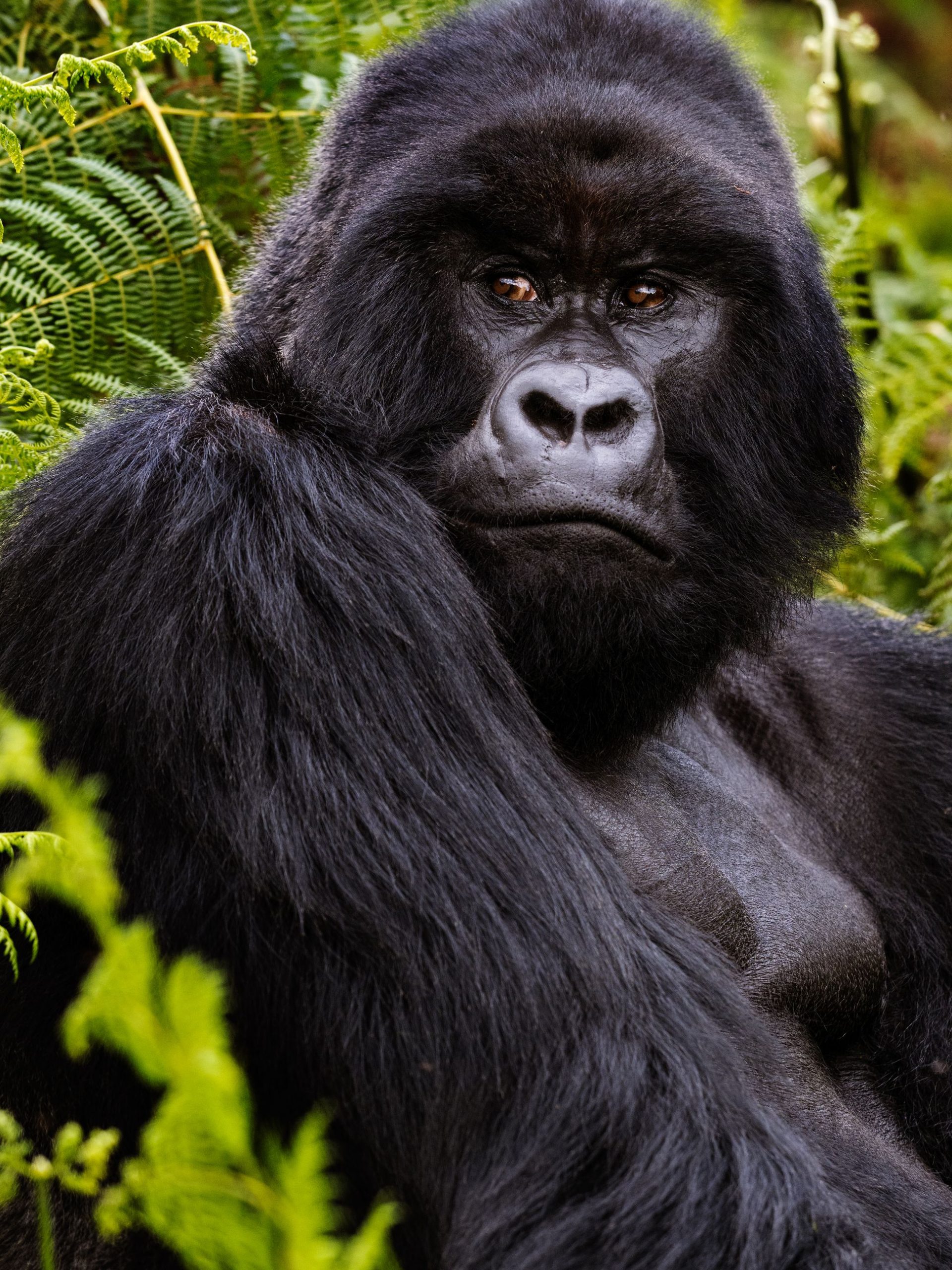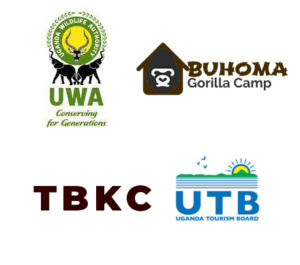
Volcanoes National Park is the leading gorilla trekking destination in Rwanda and the best place to see the endangered mountain gorillas in this country while in their natural habitats. Covering about 16,000 hectares of the total surface area, Volcanoes National Park is situated in the northwestern part of Rwanda.
The park is dominated by swamps, bamboo forests, Afro-montane forests, and savanna grassland alongside 5 volcanoes that are part of the Virunga region which include mountains Karisimbi, Bisoke, Sabyinyo, Gahinga and Muhabura. Established in 1925, Volcanoes’ major aim was to find a safe home for orphaned mountain gorillas and other primate species.
The park later faced challenges, especially during the 1994 Rwandan genocide that later saw the park’s headquarters go down. After all the instabilities the park is now safe and in 2005, the gorilla naming ceremony known as “Kwata Izina” was introduced and now the park attracts visitors from across the world.
Other Activities In Volcanoes Np Apart From Gorilla Trekking.

Visiting the famous caves of Musanze
Situated near the Volcanoes National Park in the vibrant town of Musanze, the historical Musanze caves are undoubtedly one of the key tourism destinations in Rwanda. The caves also stretch to the popular volcanoes of Bisoke and Sabyinyo and are believed to be about 65 million years old. While at Volcanoes National Park, Visitors can also get an opportunity to visit and learn about these features that attract visitors from across the globe. The Musanze caves carry such a captivating story and are believed by the locals to be once the hiding grounds of the local Kings during tribal wars making them a must-visit.

Golden monkey tracking
Aside from the endangered mountain gorillas sheltered in Volcanoes National Park, there are also other primates in the park including endangered golden monkeys. These primate species are charismatic and very pleasing to look at while they share their habitats with the mountain gorillas making their encounter a walkover. Whereas trekking the mountain gorillas can be quite challenging, tracking the golden monkeys is less challenging as they tend to live on lower slopes. Their bamboo shoot leftovers can also be used as tracking points. Tracking the golden monkeys starts at the same time as that of mountain gorillas and the whole tracking process is quite similar.

Visiting Diane's grave.
Diane Fossey was a renowned researcher, zoologist and an outstanding primatologist who made her name as a strong advocate for anti-poaching of the gentle mountain gorillas who later got murdered and died of her good cause while her tomb was laid in Volcanoes National Park in remembrance of her work. Diane through her advocacy and extensive research about the primates made the entire world know about the good side of protecting mountain gorillas. The numbers of these primate species that had greatly reduced as a result of poaching later started to increase to a reasonable size as a result of her strong will to end all the wildlife illegal activities to the mountain gorillas. She engaged in gorilla habituation, research and conservation voluntarily and later even gained the trust of some silver backs. While on Volcanoes safari tours, visitors can also go ahead to visit her grave and learn about this prominent primatologist and her research.

Hiking tours.
Volcanoes National Park’s location in the Virunga region makes it part of the Virunga ranges and features some volcanoes that can be visited while at the park. The most noticeable volcanoes include Mount Karisimbi and Mountain Bisoke where both mountains take about 2 to 1 day to hike respectively. All hiking activities in Volcanoes National Park start at around 7:00 am with a simple briefing at the park’s headquarters. Hiking these volcanoes especially Mount Bisoke gives visitors a rare opportunity to witness a fascinating crater lake at the summit. Making it to the summit of these volcanoes will also enable visitors to have the most spectacular views of Virunga volcanoes and several iconic national parks.
Visiting the famous caves of Musanze.
Situated near the Volcanoes National Park in the vibrant town of Musanze, the historical Musanze caves are undoubtedly one of the key tourism destinations in Rwanda.The caves also stretch to the popular volcanoes of Bisoke and Sabyinyo and are believed to be about 65 million years old. While at Volcanoes National Park, Visitors can also get an opportunity to visit and learn about these features that attract visitors from across the globe.The Musanze caves carry such a captivating story and are believed by the locals to be once the hiding grounds of the local Kings during tribal wars making them a must-visit.
Golden monkey tracking.
Aside from the endangered mountain gorillas sheltered in Volcanoes National Park, there are also other primates in the park including endangered golden monkeys. These primate species are charismatic and very pleasing to look at while they share their habitats with the mountain gorillas making their encounter a walkover.
Whereas trekking the mountain gorillas can be quite challenging, tracking the golden monkeys is less challenging as they tend to live on lower slopes. Their bamboo shoot leftovers can also be used as tracking points. Tracking the golden monkeys starts at the same time as that of mountain gorillas and the whole tracking process is quite similar.
Visiting Diane's grave
. Diane Fossey was a renowned researcher, zoologist and an outstanding primatologist who made her name as a strong advocate for anti-poaching of the gentle mountain gorillas who later got murdered and died of her good cause while her tomb was laid in Volcanoes National Park in remembrance of her work.
Diane through her advocacy and extensive research about the primates made the entire world know about the good side of protecting mountain gorillas. The numbers of these primate species that had greatly reduced as a result of poaching later started to increase to a reasonable size as a result of her strong will to end all the wildlife illegal activities to the mountain gorillas.
She engaged in gorilla habituation, research and conservation voluntarily and later even gained the trust of some silver backs. While on Volcanoes safari tours, visitors can also go ahead to visit her grave and learn about this prominent primatologist and her research.
Hiking tours.
. Volcanoes National Park’s location in the Virunga region makes it part of the Virunga ranges and features some volcanoes that can be visited while at the park. The most noticeable volcanoes include Mount Karisimbi and Mountain Bisoke where both mountains take about 2 to 1 day to hike respectively. All hiking activities in Volcanoes National Park start at around 7:00 am with a simple briefing at the park’s headquarters.
Hiking these volcanoes especially Mount Bisoke gives visitors a rare opportunity to witness a fascinating crater lake at the summit. Making it to the summit of these volcanoes will also enable visitors to have the most spectacular views of Virunga volcanoes and several iconic national parks.
How Much Does Gorilla Trekking Cost In Rwanda?
Unlike the other two homes of the endangered mountain gorilla – Uganda and the Democratic Republic of Congo, Rwanda has the most expensive gorilla trekking permits among all the three hosts and this has been led by the tremendous efforts put up by the Rwanda Development Board to boost and promote the country’s tourism sector.
Gorilla trekking permits in Rwanda will allow visitors to access the gorilla trekking destination and spend quality time for one hour with the endangered mountain gorillas in their natural habitats and go for 1500 USD per person per trek.
How Much Does Gorilla Trekking Cost In Rwanda?
Unlike the other two homes of the endangered mountain gorilla – Uganda and the Democratic Republic of Congo, Rwanda has the most expensive gorilla trekking permits among all the three hosts and this has been led by the tremendous efforts put up by the Rwanda Development Board to boost and promote the country’s tourism sector.
Gorilla trekking permits in Rwanda will allow visitors to access the gorilla trekking destination and spend quality time for one hour with the endangered mountain gorillas in their natural habitats and go for 1500 USD per person per trek.
When To Do Gorilla Trekking In Volcanoes National Park?
The best time for gorilla trekking safaris in Rwanda is the dry season of the year even though the activity can be done throughout the whole year. Gorillas trekking during the dry period will enable visitors to have a full ultimate experience with the endangered mountain gorillas while manoeuvring through the thick forests of Volcanoes easily without complications that might have been caused by rains for example muddy and slippery trails making it hard to hike and get to the destination.
The dry season of July to September and December to February remains the best time to dive into the wilderness of Volcanoes and engage in gorilla trekking activities. Visitors can also be rest assured to have clear views of other mammal species in the park as a result of reduced short vegetation. Choosing the right time for gorilla trekking almost gets half of the gorilla trekking done as it offers a less stressful experience, unlike the wet season.
What our customers Say ?
ExcellentBased on 21 reviews
 Headspun2023-07-16Unforgettable Rwanda Emerald tailored our 5 day trip to Rwanda to all our many and frequently changing requests without any fuss. Chris, our driver/guide for the duration, could not have been more helpful and professional
Headspun2023-07-16Unforgettable Rwanda Emerald tailored our 5 day trip to Rwanda to all our many and frequently changing requests without any fuss. Chris, our driver/guide for the duration, could not have been more helpful and professional Nic2022-10-25Amazing holidays! Great holidays! Even my special wishes were included into the planning although time was short. Our guide and driver City Tyson Magezi was caring and responsible. We traveled for four weeks and stayed in different accommodations from hut to tent to amazing hotels.
Nic2022-10-25Amazing holidays! Great holidays! Even my special wishes were included into the planning although time was short. Our guide and driver City Tyson Magezi was caring and responsible. We traveled for four weeks and stayed in different accommodations from hut to tent to amazing hotels. Susanne2022-08-19Just amazing It felt so safe and comfortable and exciting to travel with emerald. Our guide was so caring, so experienced and always friendly and an a great mood. He showed us so many animals included lions and leopards. That was just amazing . We saw wonderful landscapes like waterfalls and had contact to people . No Uganda or Eastern Africa without emerald . I m deep in love with Uganda and will come back as soon as possible.
Susanne2022-08-19Just amazing It felt so safe and comfortable and exciting to travel with emerald. Our guide was so caring, so experienced and always friendly and an a great mood. He showed us so many animals included lions and leopards. That was just amazing . We saw wonderful landscapes like waterfalls and had contact to people . No Uganda or Eastern Africa without emerald . I m deep in love with Uganda and will come back as soon as possible. Jose Murta2022-05-13Memorable Family Trip in Uganda Fantastic Trip that exceeded our expectations! Travelled to Uganda with wife and 2 children (9 and 10y old) for 7 days. Since the start (at planning stage) got a great support from Bob (company owner) and Edmund (our guide) via WhatsApp. They tailored a program to our needs including the unforgettable mountain gorillas hike, general hikes to waterfalls, safari including boat trip to see hipos!! Edmund, our guide, always super polite and the kids enjoyed him a lot! All our hotels, meals included in the package so no hassle on this….we just paid for drinks! The only regret I have is not staying one extra day in the Mburo National Park to explore a bit more ;) Memorable trip with so much nature and a super-humble people that made the experience even more enjoyable!! Super recommend!! The whole family just feeling we need to get back to explore more ;)
Jose Murta2022-05-13Memorable Family Trip in Uganda Fantastic Trip that exceeded our expectations! Travelled to Uganda with wife and 2 children (9 and 10y old) for 7 days. Since the start (at planning stage) got a great support from Bob (company owner) and Edmund (our guide) via WhatsApp. They tailored a program to our needs including the unforgettable mountain gorillas hike, general hikes to waterfalls, safari including boat trip to see hipos!! Edmund, our guide, always super polite and the kids enjoyed him a lot! All our hotels, meals included in the package so no hassle on this….we just paid for drinks! The only regret I have is not staying one extra day in the Mburo National Park to explore a bit more ;) Memorable trip with so much nature and a super-humble people that made the experience even more enjoyable!! Super recommend!! The whole family just feeling we need to get back to explore more ;) Dwayne B2022-05-13Great Experience With Emerald!! It was an amazing experience! My guides Lucky and Hillary made me feel as if I was family and took care of everything I needed. They were very knowledgeable as we trekked to gorillas in Bwindi and a ride a wildlife safari through Queen Elizabeth. I learned so much from them about the animals, the terrain and the surrounding people. They we also incredibly helpful in helping me find activities around Buhoma, where I stayed, all of which were great. By the time I left I knew I had made friends who I will continue to stay in touch with. Can’t wait to come back with my family!
Dwayne B2022-05-13Great Experience With Emerald!! It was an amazing experience! My guides Lucky and Hillary made me feel as if I was family and took care of everything I needed. They were very knowledgeable as we trekked to gorillas in Bwindi and a ride a wildlife safari through Queen Elizabeth. I learned so much from them about the animals, the terrain and the surrounding people. They we also incredibly helpful in helping me find activities around Buhoma, where I stayed, all of which were great. By the time I left I knew I had made friends who I will continue to stay in touch with. Can’t wait to come back with my family! Dávid B2022-05-12Feeding python - 9 lions on a tree - leopard vs. lion We saw all animals and extremely special situations in a short period of time, good organization and friendly guide Paul with lots of knowledge.
Dávid B2022-05-12Feeding python - 9 lions on a tree - leopard vs. lion We saw all animals and extremely special situations in a short period of time, good organization and friendly guide Paul with lots of knowledge. Rachmurta2022-05-10Unforgettable trip! We spent one week in Uganda travelling by the guidance of Gorilla Experience safari. The whole experience were definitely above our expectations. Edmand was a friendly, polite and kind guide the whole time!
Rachmurta2022-05-10Unforgettable trip! We spent one week in Uganda travelling by the guidance of Gorilla Experience safari. The whole experience were definitely above our expectations. Edmand was a friendly, polite and kind guide the whole time! Vit Siv2022-04-22Ultimately Unique Experience of Uganda! It was unbelievable unique experience, one in a life time. Everything right from arrival to minor ditals was taken care of, too service! Itinerary was compiled/tailor to our wishes and needs as well as to include as much activities as possible. Tyson was our guide. He is an amazing guide, but even better person. He did an incredible job to put this all together, and make it all happen. We managed to do everything we wanted and even more. Definitely a trip to remember!!
Vit Siv2022-04-22Ultimately Unique Experience of Uganda! It was unbelievable unique experience, one in a life time. Everything right from arrival to minor ditals was taken care of, too service! Itinerary was compiled/tailor to our wishes and needs as well as to include as much activities as possible. Tyson was our guide. He is an amazing guide, but even better person. He did an incredible job to put this all together, and make it all happen. We managed to do everything we wanted and even more. Definitely a trip to remember!! Emmanuel OKalany2022-01-08A rewarding experience for a family visit to queen Elizabeth National Park My family and I had an excellent guided tour to Queen Elizabeth National Park. The itinerary planning provided was good and the costing of items was realistic. The care and hospitality of the team was excellent. They were also flexible to make time adjustments brought about because of traveling with children
Emmanuel OKalany2022-01-08A rewarding experience for a family visit to queen Elizabeth National Park My family and I had an excellent guided tour to Queen Elizabeth National Park. The itinerary planning provided was good and the costing of items was realistic. The care and hospitality of the team was excellent. They were also flexible to make time adjustments brought about because of traveling with children Gordon Y2021-06-23Trip to Kaiso Tonya Game Reserve The guide/driver was too keen to find out my interests. That way, we always had something to talk abouts. Thank you
Gordon Y2021-06-23Trip to Kaiso Tonya Game Reserve The guide/driver was too keen to find out my interests. That way, we always had something to talk abouts. Thank you



